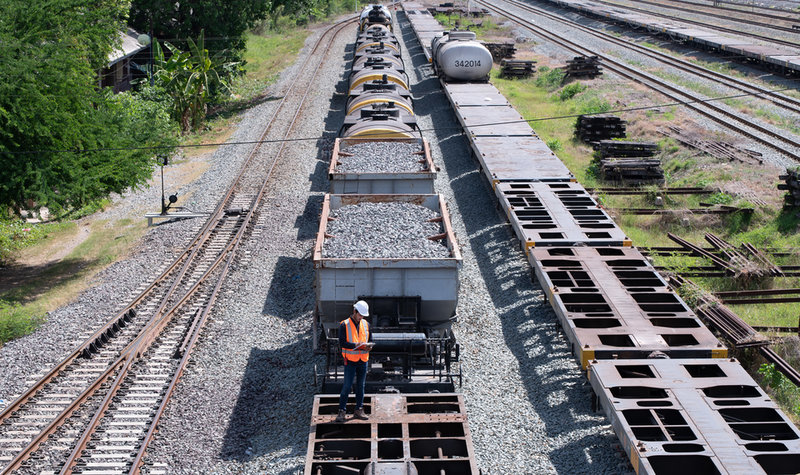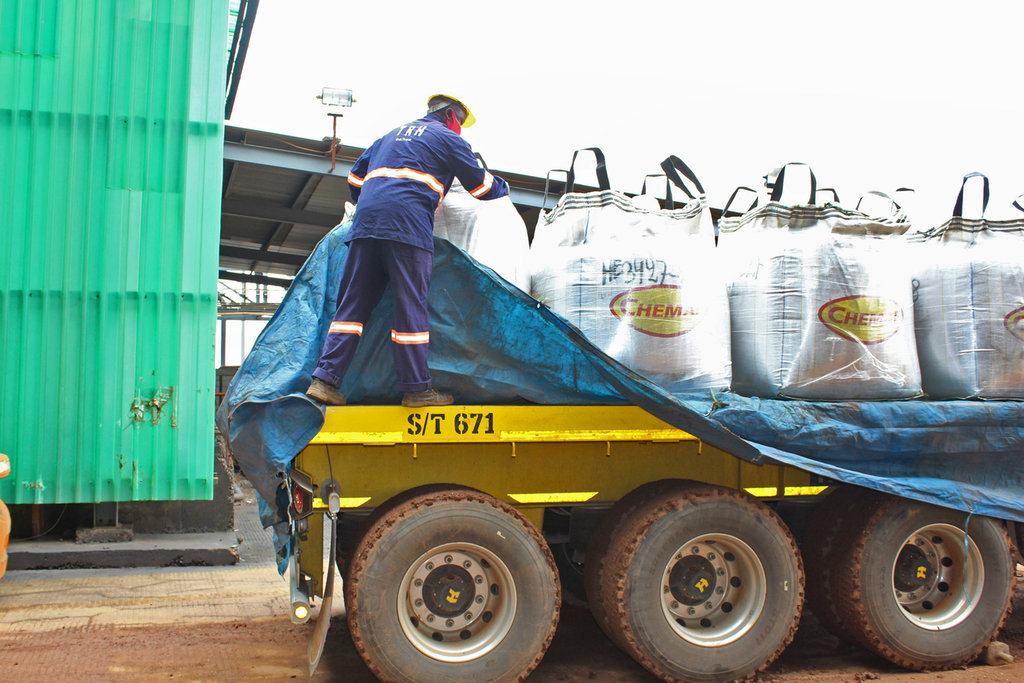Feature
Transparency in supply: Putting minerals on the blockchain
Tracking minerals on the blockchain could tackle one of the industry’s biggest ESG concerns, and prevent funds falling into the hands of exploiters. Nnamdi Anyadike examines the projects enabling transparency in supply chains.

Inspecting rail shipments. Credit: APChanel via Shutterstock
For years, blockchain has promised greater transparency to mining supply chains then somewhat failed to deliver. Much of this failure is down to mine companies underestimating the extent and nature of the challenge of incorporating blockchain-enabled technology into their mining supply chains. As outlined in Blockchain in Metals Mining, a paper by Mine Magazine’s parent company GlobalData, “The mining industry’s supply chain is extremely complex due to the typically long life of the deposit and the processes involved in extracting the mineral from the mine.”
But now it looks as though blockchain is finally coming of age. Blockchain can allow mining companies to track and trace mine resources throughout the supply chain from source to end use. This ability is of paramount importance, particularly when dealing with materials sourced from unregulated areas.
A spokesperson for JHR Africa, a Kenya-based coal and fly ash trading company start-up, commented: “One of the main advantages of using blockchain technology in Africa’s mining industry is that it can help to address the issue of ‘conflict minerals’, minerals that are mined in conflict regions are often used to finance armed groups. By using blockchain technology to track the origin of minerals, mining companies can ensure that they are not inadvertently supporting such activities.”
EU trials African mine tracing in Liberia
In response to concerns about the trade in African conflict minerals, the EU has introduced a number of track and trace initiatives. In August, it embarked on a blockchain-enabled trial project to track off-grid, “artisanal” mining in Africa. Called the Raw Materials Radar Consortium (RMR), and backed by the EU-funded EIT Raw Materials, the project seeks to enhance artisanal small-scale mining practices in Liberia. The objective is to develop a software and hardware solution that will use blockchain together with Internet of Things (IoT) technologies to trace the origin, ownership, and provenance of raw materials. Eventually, project leaders intent to expand the platform into other African and global markets.

Cobalt, ready for export from the Democratic Republic of the Congo. Credit: Lucien Kahozi/Bloomberg via Getty Images
RMR’s solution consists of IoT kits that incorporate digitally-connected weighing scales and tracking devices for material shipments. The system will also enable the automatic weighing and recording of material ownership by suppliers on-site. When the quality of the materials has been evaluated, the data will be digitised, and a connected tracking device will then seal the container for continuous monitoring until final delivery. The entire process will be securely stored in a blockchain-based infrastructure. Independent third parties will be able to transparently verify and certify adherence to predefined process standards and regulations.
The system will also enable the automatic weighing and recording of material ownership by suppliers on-site.
Four complimentary organisations are involved in the consortium. Fondazione Bruno Kessler is the project coordinator, through its OpenIoT Research Unit. The company’s primary responsibilities include designing and developing IoT sensor devices and integrating them into the blockchain-based infrastructure. Mining consultancy company ECTerra has a speciality in the mining of tantalum ores and acts as the RMR’s commercialisation partner through UP Cape Partnership (UCP), a company established by ECTerra in Liberia. Fondazione Hub Innovazione Trentino is a non-profit foundation that will manage intellectual property and offer support to ECTerra. Finally, Minespider is a technology company that is contributing its expertise in developing blockchain-based platforms for tracking mineral supply chain data.
Three-year EU raw materials “passport” scheme launched
The artisanal minerals tracking project is complementary to other EU blockchain initiatives, such as its critical minerals passport project “Material and Digital Traceability for the Certification of Critical Raw Materials” - MaDiTraCe that commenced in January and will run until 2025. The three-year project, coordinated by (French Geological Survey BRGM, brings together 14 partners from seven countries to develop and integrate technological solutions for traceability and certification into a Digital Product Passport.
These artificial fingerprinting solutions help to provide trust and verification of ESG sustainability claims through traceable responsible sourcing of critical raw materials.
In August, UK-based metals inspection company Alfred H Knight announced its participation in the scheme. Its role focuses on the development of artificial fingerprinting technologies that will be used as to create “material passports” for lithium and cobalt in two complex supply chains, namely rechargeable lithium-ion batteries and magnets. It also aims to reinforce the transparency, traceability and sustainability of complex supply chains of other critical raw materials, including cobalt and natural graphite as well as rare earth elements.
Aldwin Vogel, regional general manager for Northern Europe at Alfred H Knight, explains: “By assisting in the development of these artificial fingerprinting solutions, we help to provide trust and verification of environmental, social, and governance [ESG] sustainability claims through traceable responsible sourcing of critical raw materials.”
IBM blockchain mining initiative expands
The EU-funded MaDiTraCe initiative is but the latest in a line of similar multilateral initiatives that have been put in place over the past few years, including the Responsible Sourcing Blockchain Network (RSBN). Launched by RCS Global and IBM in 2019, it has now expanded to include a number of mining companies, technology firms, and NGOs. The collaboration aims to create a blockchain-based system for tracking and verifying the origin of minerals, such as cobalt and tantalum, that are commonly used in consumer electronics. RSBN allows companies to track the entire supply chain of a mineral, from the point of extraction to the point of sale, ensuring that it has been produced responsibly.

Copper shipments in Zambia. Credit: Zinyange Auntony/Bloomberg via Getty Images
“From the time raw materials for batteries are produced at a participating industrial mine site in the Democratic Republic of Congo, RSBN relies on IBM’s blockchain platform to trace the material to a smelter, a cathode plant, a Li-ion battery plant and, finally, to an automobile or electronics manufacturing plant,” said Dr. Nicholas Garrett, CEO of sourcing technology company RCS Global Group. In addition to providing end-to-end traceability, the RSBN platform uses RCS Global’s responsibility scores for each participant in the supply chain, based on auditing.
“Our collective effort allows participating companies to gain greater efficiency in risk management by combining necessary human-led assurance efforts with technology-led efficiency improvements, particularly in data exchange. This is a demonstration of technology for good, enabling a more effective risk management approach which can have greater impact on conditions in the worldwide minerals sector,” Garrett adds.
Challenges continue to impede blockchain
JHR Africa cautions that the use of blockchain technology in the mining industry is not without its challenges. “One key issue is the cost and complexity of implementing a blockchain-based system, particularly for smaller mining companies. Blockchain technology requires a significant investment in hardware and software, as well as the expertise to implement and maintain the system,” a company spokesperson says.
Another challenge is the scalability of blockchain technology. “The mining industry generates vast amounts of data, and it is not yet clear whether blockchain technology can handle the volume of data generated by the industry,” it adds.
Maintaining the blockchain requires power, time, and technological endeavour, but this open-source method of tracking shipments holds great potential for improving supply chain transparency and accountability, and for ensuring that minerals are sourced responsibly. It also provides the mining industry with the means to counter the widespread criticism over its environmental and social impacts, as well as concerns over the transparency and traceability of its supply chains. As the technology continues to develop, becoming more accessible and better recognised, it is likely that we will see more mining companies adopting blockchain-based systems in the future.